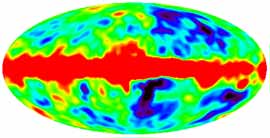|
|
 |
Cosmology based on CMB experiments entered a
new era early in the 1990s, when NASA's Cosmic Background Explorer (COBE)
flew an experiment conceived by George Smoot, an astrophysicist with
Berkeley Lab's Physics Division and professor of physics at the University
of California at Berkeley. Smoot's COBE experiment measured small
variations in the temperature of the otherwise featureless microwave
background for the first time.
 |

THIS SKYMAP SHOWS TINY VARIATIONS IN THE INTENSITY OF THE COSMIC
MICROWAVE BACKGROUND MEASURED BY COBE PROJECT SCIENTISTS. THE
BLUE AND RED SPOTS CORRESPOND TO REGIONS OF GREATER OR LESSER
DENSITY IN THE EARLY UNIVERSE. THESE "FOSSILIZED"
RELICS RECORD THE DISTRIBUTION OF MATTER AND ENERGY IN THE EARLY
UNIVERSE BEFORE IT BECAME ORGANIZED INTO STARS AND
GALAXIES. THE COBE SATELLITE MAPPED THE SKY WITH AN
ANGULAR RESOLUTION OF ABOUT 10 DEGREES. THE BOOMERANG NORTH AMERICA
TEST FLIGHT MAPPED A THIN STRIP OF SKY AT A RESOLUTION OF 16.6 ARC
MINUTES.
|
The cosmic microwave background represents the moment, 300,000 years
after the hot Big Bang, when temperatures had cooled enough for protons to
capture free electrons and form hydrogen atoms. Photons, freed from
scattering interactions with electrons, streamed away from the vanished
surface of this photon-electron-baryon fluid. As they reach us today,
these photons have lost energy, "cooled off," to the equivalent
of those emitted by a black body at a temperature less than three degrees
above absolute zero.
Before this fluid condensed into atoms and photons, pressure
oscillations were moving at the speed of sound through the dense hot blob.
Gravity pulled in and radiation pressure pushed out, making the whole
spherical mass ring like a bell; at the moment the photons were freed,
some regions were contracting, heated by compression, and other, cooler
regions were expanding; these motions imprinted temperature differences on
the cosmic microwave background and recorded the harmonics of the sound
wave.
The sound wave reveals the precise characteristics of its resonating
chamber -- which was the entire universe at that moment. Measuring the
smallest possible angles between pairs of warmer or cooler points on a
fine-scale map of today's microwave sky yields a CMB power spectrum, a
graph that reveals such basic parameters as whether the universe is flat
or open.
In a flat universe, with familiar geometry, the sound wave would have
traveled across a cosmos equivalent in dimension to a single degree of
today's sky; thus the oscillations we see today would repeat on a scale of
about one degree. But an open universe is one in which space is
"negatively curved;" similar oscillations today would appear
smaller. Thus by determining the scale at which the oscillations repeat --
closer to one degree, or closer to half a degree -- it is possible to
determine whether the universe is flat or open.
Other kinds of information also reside in the pattern of anisotropies.
"We owe the stars and galaxies -- all the concentrations of matter
essential to our existence -- to minute density perturbations in the
primordial universe," says astrophysicist and computer scientist
Julian Borrill of the National Energy Research Computing Center (NERSC).
"Alternative cosmologies try to account for these perturbations in
different ways. Each model generates a specific waveform, starting with a
large peak representing the fundamental harmonic. The harmonic in
inflation models is followed by resonances, a series of smaller peaks.
Models incorporating defects in the early universe probably just 'ramp
down.' To choose among models, we need to derive the real curve."
The COBE data established points on the lower slope of the first peak
of the waveform; analysis of the BOOMERanG North America data set has
roughed out the shape of this peak, whose position favors a flat universe
and whose large amplitude is consistent with the idea that some unknown
force, in addition to an initial push from the Big Bang, is driving
universal expansion -- presumably the cosmological constant. The evidence
for the cosmological constant is further strengthened by comparing
independent data from distant supernovae.
To extend the curve of CMB power spectrum, the current generation of
CMB experiments were designed to measure even smaller anisotropies, over
even more sky, at even higher resolution. The COBE satellite detected
variations in temperature as small as one part in 100,000 and mapped the
sky with an angular resolution of about 10 degrees; the PLANCK satellite,
planned to fly in 2007, will detect variations as small as one part in a
million with a resolution of 10 arc-minutes -- and over the entire sky.
Apart from the sheer size of the new data sets, separating very weak
signals from noise will pose a mounting challenge to computational
analysis of the CMB in the years to come. NERSC is determined to meet the
challenge, whose reward will be a treasury of priceless information about
the structure and evolution of our universe, from its earliest visible
moment until the present.
Additional Information:
|


